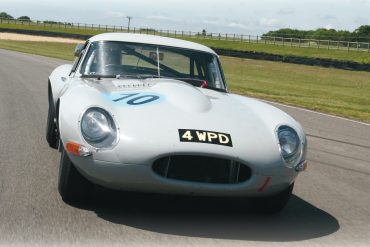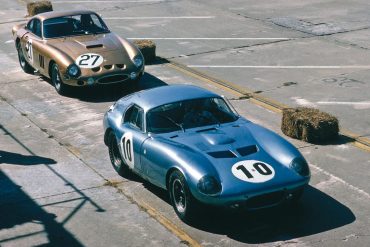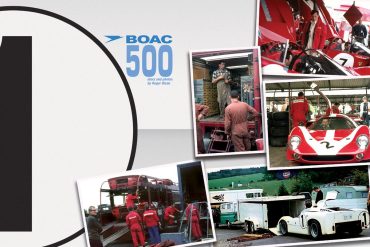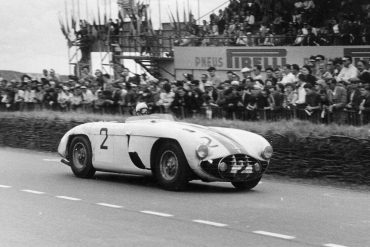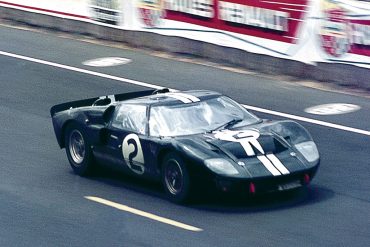Heavy Duty Lightweights 1961 Jaguar XKE “Coombs Lightweight” & 1963 Jaguar XKE “Qvale Lightweight” Photo: Pete Austin The year 2011 marks 50...
June 2, 2020, marked half a century since the death of pioneering racing driver and engineer Bruce McLaren, who was...
Alistair Caldwell joined the McLaren team in their early days as a cleaner and ended up as team manager, winning two World Championships—with Emerson Fittipaldi and James Hunt. Here, he shares with Keith Booker some of his recollections of those early days. How did you first become involved in motor...
The 27th edition of the Silverstone Classic, now firmly established as the world’s biggest classic motor racing festival, once again...
Peter Collins Sir Stirling Moss 2 Stirling Moss drives a Maserati 250F to victory in the Glover Trophy Race at...
Ronnie Peterson Giuseppe Campari 1 James Hunt, driving a McLaren-Ford, wins the German Grand Prix on the Nürburgring. Niki Lauda crashes his Ferrari on the second lap and suffers serious burns that nearly kill him. Six weeks later, Lauda returns to racing (1976). 2 Ronnie Bucknum debuts the Honda RA271...
Mark Donohue Bruce McLaren 1 “Big Daddy” Don Garlits becomes the first dragracer to run the 1/4 mile at more...
Howden Ganley stopped by our vendor booth at the recent Rolex Monterey Motorsports Reunion, where one of the old photos...
As you’ll read in this month’s news, Bette Hill, wife of World Champion Graham and mother of World Champion Damon, has passed away at the age of 91. After meeting future husband Graham, at a rowing club function in 1950, Bette would four years later be swept up into the...
Briggs Cunningham was one of the most important figures in U.S. road racing during the era of the 1950s. He...
I chose to depict Bruce McLaren in his Papaver Orange car as I wanted to portray the beautifully sculpted mechanical details of the riveted, sheet aluminum cars from that era. The honest suspension in all its painted or plated steel and rose-jointed glory unfettered by billboard writing or any other sanitizing,...
We called it the “Bruce and Denny Show,” and it was total dominance of the Can-Am Championship by McLaren Cars...
Bruce McLaren Biography Bruce McLaren was born to Les (Pop) & Ruth on 30th August 1937 at Auckland, New Zealand,...
John Rice produced a series of a dozen watercolor paintings for a show celebrating memorable moments at Watkins Glen, with this particular example depicting Bruce McLaren winning the 1969 Watkins Glen Can-Am in his all-conquering M8B. The M8Bs won every race on the Can-Am schedule that year as the “Bruce...
Bruce Leslie McLaren won the first-ever Grand Prix of the United States in 1959, but really established his life’s legacy...
Pete Lyons Hail the “Mod Scot!” Such a thought must have flickered through many minds as 27 Group 7 machines...
Next July’s Silverstone Classic has announced plans to celebrate the 50th anniversary of the legendary Can-Am Series with a pair of special commemoration races at its annual summer event, set for July 29-31. The two races will be the culmination of a three-round Can-Am 50 Interserie Challenge being organized by...
As you’ll read in this month’s Racecar Profile, I was given a rare opportunity to drive one of the ultimate...
Pete Lyons The year was 1970. The year the ground turned over under America’s greatest sports racing car series. It...
The Canadian American Challenge Cup (Can-Am) was co-sanctioned by the SCCA and CASC; it was a series nicknamed the “unlimited” series. Although there was a basic set of rules, the cars had to be two-seaters with bodywork covering the wheels, doors, a windscreen, brake lights and meet various safety requirements....
The Canadian American Challenge Cup (Can-Am) was cosanctioned by the SCCA and CASC; it was a series nicknamed the “unlimited”...
The Canadian American Challenge Cup was co-sanctioned by the SCCA and CASC—it was a series nicknamed the “unlimited” series. Although...
The Canadian American Challenge Cup was co-sanctioned by the SCCA and CASC—it was a series nicknamed the “unlimited” series. Although there was a basic set of rules, the cars had to be two-seaters with bodywork covering the wheels, have doors, a windscreen, brake lights and various safety requirements. However, there...
The Canadian American Challenge Cup was co-sanctioned by the SCCA and CASC—it was a series nicknamed the “unlimited” series. Although...
The Canadian American Challenge Cup was co-sanctioned by the SCCA and CASC, and quickly became known as the “unlimited” series....
The Canadian-American Challenge Cup was a series nicknamed the “unlimited” series co-sanctioned by the Sports Car Club of America and the Canadian Automobile Sport Clubs. Although there was a basic set of rules—the cars had to be two-seaters with bodywork covering the wheels, have doors, a windscreen, brake lights, and...
By almost anyone’s measure, one of the things that made the Golden Era golden was the Canadian-American Challenge Cup or...
The Canadian American Challenge Cup was co-sanctioned by the SCCA and CASC—it was a series nicknamed the “unlimited” series. Although...
The Canadian American Challenge Cup, co-sanctioned by the SCCA and the CASC, was essentially an “unlimited” series. Although there was a basic set of rules, the cars merely had to be two-seaters with bodywork covering the wheels, doors, a windscreen, brake lights and various safety requirements. There was no regulation...


